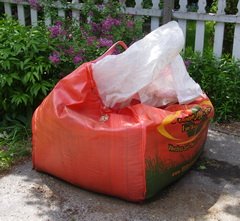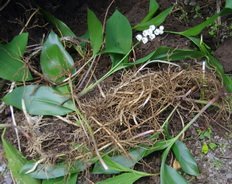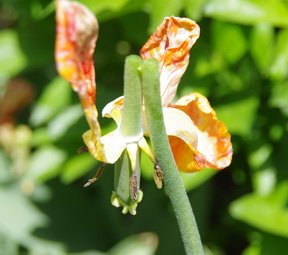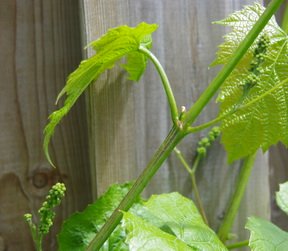| Back to Back Issues Page |
 |
|
Dallying In The Dirt, Issue #127 --- There's a bag of Duck doo in my driveway. May 24, 2013 |

Just when I think that this is the year that things are going to go smoothly and I will have time to get all of my planting done just when it should be, somebody throws a wrench into the works. It’s often more than one wrench but who’s counting. The ground level wooden deck is caving in and needs to be rebuilt. All of the underpinning wood stringers have rotted away from being in constant contact with the soil. I have to look for some other material or style to replace it with, as I don’t want to be repeating this process in another ten years. When I was at Canada Blooms in March it seemed like a great idea to try a new compost made from Duck manure. It’s probably still a good idea, I’m just not sure I needed it dropped into my driveway this week. Not on the schedule and there is no point in adding it to the perennial beds before they get a good weeding. Stop planting, start weeding and spreading duck doo.  We continue to pick Asparagus faster then we can eat it. As a result a large bag of it is accumulating in the fridge. It keeps well and we will eat it as the production slows but we also turn it into soup to freeze and we parboil it and then marinate it in oil and lemon juice to make a very tasty salad. I noticed yesterday that the Rapini and Pak Choi were ready to pick and so our palate of veggies starts to expand on almost a daily basis.
We continue to pick Asparagus faster then we can eat it. As a result a large bag of it is accumulating in the fridge. It keeps well and we will eat it as the production slows but we also turn it into soup to freeze and we parboil it and then marinate it in oil and lemon juice to make a very tasty salad. I noticed yesterday that the Rapini and Pak Choi were ready to pick and so our palate of veggies starts to expand on almost a daily basis. Some poor planning, or probably a complete absence of same, has me adding another chore to the mid summer list. One of my very pretty new Iris is a mid sized, early variety that is in full bloom surrounded by the late Tulips and is therefore rendered almost invisible. It will have to be moved so that it can be appreciated. A little planning in the garden can certainly save a lot of work adjusting things later. I believe that one of my talks is on garden design and planning. I should probably listen to myself.
Some poor planning, or probably a complete absence of same, has me adding another chore to the mid summer list. One of my very pretty new Iris is a mid sized, early variety that is in full bloom surrounded by the late Tulips and is therefore rendered almost invisible. It will have to be moved so that it can be appreciated. A little planning in the garden can certainly save a lot of work adjusting things later. I believe that one of my talks is on garden design and planning. I should probably listen to myself. I spent an inordinate amount of time creating a new little garden bed this week. It’s a semicircle about 2 M wide at the back and not more than a metre deep in the centre. I decided that I really didn’t need that bit of space filled with Lily of the Valley when I could grow other things there. It’s not that I don’t like Lily of the Valley and its wonderfully scented flowers but I have it in other spots and I needed room for a few new plants that mysteriously showed up at the house. Did you know that Lily of the Valley’s great spreading roots can be very thick and at least 20 cm deep. A massive dig was undertaken in an attempt to remove all traces of these roots so that I will not be forever cursing their reappearance. It would be easier if I was just able to dig up huge chunks of this plant and dispense with it but that would mean throwing away a large quantity of good but also heavy, soil. Separating the roots and retaining the soil added considerable time to this “little” project. The new bed looks lovely but its size belies the effort required to rescue it from the clutches of the dense growth of its Lily of Valley. A trip to the local garden centre allowed me to see a 10 cm pot with a sprig of that plant selling for a few dollars. I must have tossed out several thousand dollars worth of the stuff.
I spent an inordinate amount of time creating a new little garden bed this week. It’s a semicircle about 2 M wide at the back and not more than a metre deep in the centre. I decided that I really didn’t need that bit of space filled with Lily of the Valley when I could grow other things there. It’s not that I don’t like Lily of the Valley and its wonderfully scented flowers but I have it in other spots and I needed room for a few new plants that mysteriously showed up at the house. Did you know that Lily of the Valley’s great spreading roots can be very thick and at least 20 cm deep. A massive dig was undertaken in an attempt to remove all traces of these roots so that I will not be forever cursing their reappearance. It would be easier if I was just able to dig up huge chunks of this plant and dispense with it but that would mean throwing away a large quantity of good but also heavy, soil. Separating the roots and retaining the soil added considerable time to this “little” project. The new bed looks lovely but its size belies the effort required to rescue it from the clutches of the dense growth of its Lily of Valley. A trip to the local garden centre allowed me to see a 10 cm pot with a sprig of that plant selling for a few dollars. I must have tossed out several thousand dollars worth of the stuff. One of the easier jobs right now is encouraging all of the Tulips to grow nice fat bulbs for next year. This is done by wandering through the garden and deadheading them. Removing the spent flowers stops the plant from using up its energy making seeds and allows all of that energy to be used to regenerate the bulb. It’s light work that allows us to wander in the garden. It makes the garden look neater and it fattens the bulbs. Truly a rewarding task. The Narcissus can also benefit from the same bit of care.
One of the easier jobs right now is encouraging all of the Tulips to grow nice fat bulbs for next year. This is done by wandering through the garden and deadheading them. Removing the spent flowers stops the plant from using up its energy making seeds and allows all of that energy to be used to regenerate the bulb. It’s light work that allows us to wander in the garden. It makes the garden look neater and it fattens the bulbs. Truly a rewarding task. The Narcissus can also benefit from the same bit of care. You may remember that I was learning how to prune my new grape vines a few weeks ago. As usual I learned more about the proper technique after I had attempted to do the job. I proudly report that my, accidentally created, 6 row Kniffen appears to have been very successful. Each little bud is throwing out some new growth that is carrying a couple of clusters of flower buds that should develop into a significant harvest of delicious grapes. A certain amount of blind luck and a touch of newly learned skill can do amazing things in a garden. Now comes the question of who will eventually harvest these delights. Can I get to them before birds. Maybe I should actually think about protecting them with a little netting. That’s a job I can certainly put farther down the list.
You may remember that I was learning how to prune my new grape vines a few weeks ago. As usual I learned more about the proper technique after I had attempted to do the job. I proudly report that my, accidentally created, 6 row Kniffen appears to have been very successful. Each little bud is throwing out some new growth that is carrying a couple of clusters of flower buds that should develop into a significant harvest of delicious grapes. A certain amount of blind luck and a touch of newly learned skill can do amazing things in a garden. Now comes the question of who will eventually harvest these delights. Can I get to them before birds. Maybe I should actually think about protecting them with a little netting. That’s a job I can certainly put farther down the list. Time to answer a few questions. If you have a gardening question just ‘reply’ to this newsletter and send me your query. I try to answer most of the questions and the ones that I answer here are those that I think will have the widest interest. You can also find the latest garden updates on the front page of gardening-enjoyed.com. I try to change it every few days so check back often. |
| Back to Back Issues Page |
 The weather is really trying to throw me off my schedule. We get a few really warm days and we start to think about adjusting the planting dates and then it drops down to 0 C for a couple of nights to remind us to stick to the tried and true schedule. This past weekend was the spring long weekend here in Canada and it is typically a big planting time but the vagaries of the calendar make it the earliest possible date this year. The 24th of May doesn’t actually arrive until the end of this week. I planted a great deal of things that should not be cool night sensitive and am hoping for the best. I do admire the tenaciousness of some of the plants that I consider weeds. Dug the bed, turned it over, handpicked all of the obvious green bits and then used the Duck doo as a mulch about and inch thick. Next morning there is a totally leafless weed poking up through the Duck doo, firmly rooted and looking to carry on with its life. If I treated any of my own plants that way they would never be seen again. Maybe I should adjust my thinking about which plants are on my “keep” list. Why fight Mother Nature? In that same bed while weeding I made a wonderful discovery. Cypripedium parviflora is a native lady slipper orchid that a neighbour had given me and I had forgotten that I had planted it there. What a delightful discovery.
The weather is really trying to throw me off my schedule. We get a few really warm days and we start to think about adjusting the planting dates and then it drops down to 0 C for a couple of nights to remind us to stick to the tried and true schedule. This past weekend was the spring long weekend here in Canada and it is typically a big planting time but the vagaries of the calendar make it the earliest possible date this year. The 24th of May doesn’t actually arrive until the end of this week. I planted a great deal of things that should not be cool night sensitive and am hoping for the best. I do admire the tenaciousness of some of the plants that I consider weeds. Dug the bed, turned it over, handpicked all of the obvious green bits and then used the Duck doo as a mulch about and inch thick. Next morning there is a totally leafless weed poking up through the Duck doo, firmly rooted and looking to carry on with its life. If I treated any of my own plants that way they would never be seen again. Maybe I should adjust my thinking about which plants are on my “keep” list. Why fight Mother Nature? In that same bed while weeding I made a wonderful discovery. Cypripedium parviflora is a native lady slipper orchid that a neighbour had given me and I had forgotten that I had planted it there. What a delightful discovery.